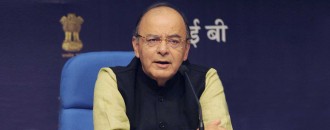
Union Cabinet okays simplification of FDI policy to attract foreign investments
Source: PIB, Government of India
The Union Cabinet, chaired by the Prime Minister Narendra Modi, has given its approval to review the existing foreign direct investment (FDI) policy on various sectors provided in the Consolidated FDI Policy Circular 2014, as amended by the Consolidated FDI Policy Circular 2015, by introducing composite caps for simplification of FDI policy to attract foreign investments. Following amendments to the relevant paragraphs of Consolidated FDI policy were approved: (a) Para 3.1.4 (i): An FII/FPI/QFI (Schedule 2, 2A and 8 of FEMA (Transfer or Issue of Security by Persons Resident Outside India) Regulations, as the case may be) may invest in the capital of an Indian company under the Portfolio Investment Scheme which limits the individual holding of an FII/FPI/QFI below 10% of the capital of the company and the aggregate limit for FII/FPI/QFI investment to 24% of the capital of the company. This aggregate limit of 24% can be increased to the sectoral cap/statutory ceiling, as applicable, by the Indian company concerned through a resolution by its Board of Directors followed by a special resolution to that effect by its General Body and subject to prior intimation to RBI. The aggregate FII/FPI/QFI investment, individually or in conjunction with other kinds of foreign investment will not exceed sectoral/statutory cap. (b) Para 3.6.2 (vi): It is also clarified that Foreign investment shall include all types of foreign investments, direct and indirect, regardless of whether the said investments have been made under Schedule 1 (FDI), 2 (FII), 2A (FPI), 3 (NRI), 6 (FVCI), 8 (QFI), 9 (LLPs) and 10 (DRs) of FEMA (Transfer or Issue of Security by Persons Resident Outside India) Regulations. FCCBs and DRs having underlying of instruments which can be issued under Schedule 5, being in the nature of debt, shall not be treated as foreign investment. However, any equity holding by a person resident outside India resulting from conversion of any debt instrument under any arrangement shall be reckoned as foreign investment. (c) Para 4.1.2: For the purpose of computation of indirect foreign investment, foreign investment in an Indian company shall include all types of foreign investments regardless of whether the said investments have been made under Schedule 1 (FDI), 2 (FII holding as on March 31), 2A (FPI holding as on March 31), 3 (NRI), 6 (FVCI), 8 (QFI holding as on March 31), 9 (LLPs) and 10 (DRs) of FEMA (Transfer or Issue of Security by Persons Resident Outside India) Regulations. FCCBs and DRs having underlying of instruments which can be issued under Schedule 5, being in the nature of debt, shall not be treated as foreign investment. However, any equity holding by a person resident outside India resulting from conversion of any debt instrument under any arrangement shall be reckoned as foreign investment. (d) Para 6.2: (i) In the sectors/activities mentioned in this paragraph, foreign investment up to the limit indicated against each sector/activity is allowed, subject to the conditions of the extant policy on specified sectors and applicable laws/regulations; security and other conditionalities. In sectors/activities not listed therein, foreign investment is permitted up to 100% on the automatic route, subject to applicable laws/regulations; security and other conditionalities. Wherever there is a requirement of minimum capitalization, it shall include share premium received along with the face value of the share, only when it is received by the company upon issue of the shares to the non-resident investor. Amount paid by the transferee during post-issue transfer of shares beyond the issue price of the share, cannot be taken into account while calculating minimum capitalization requirement. (ii) Sectoral cap that is to say the maximum amount which can be invested by foreign investor, unless provided otherwise, is composite and includes all types of foreign investments, direct and indirect, regardless of whether the said investments have been made under Schedule 1 (FDI), 2 (FII), 2A (FPI), 3 (NRI), 6 (FVCI), 8 (QFI), 9 (LLPs) and 10 (DRs) of FEMA (Transfer or Issue of Security by Persons Resident Outside India) Regulations. FCCBs and DRs having underlying of instruments which can be issued under Schedule 5, being in the nature of debt, shall not be treated as foreign investment. However, any equity holding by a person resident outside India resulting from conversion of any debt instrument under any arrangement shall be reckoned as foreign investment under the composite cap. (iii) Foreign investment in sectors under Government approval route resulting in transfer of ownership and/or control of Indian entities from resident Indian citizens to non-resident entities will be subject to Government approval. Foreign investment in sectors under automatic route but with conditionalities, resulting in transfer of ownership and/or control of Indian entities from resident Indian citizens to non-resident entities, will be subject to compliance of such conditionalities. (iv) The sectors which are already under 100% automatic route and are without conditionalities would not be affected. (v) Notwithstanding anything contained in paragraphs (i) and (iii) above portfolio investment, up to aggregate foreign investment level of 49%, will not be subject to either government approval or compliance of sectoral conditions, as the case may be, if such investment does not result in transfer of ownership and/or control of Indian entities from resident Indian citizens to non-resident entities, (vi) Total foreign investment, direct and indirect, in an entity will not exceed the sectoral/statutory cap. (vii) Any existing foreign investment already made in accordance with the policy in existence would not require any modification to conform to these amendments. (viii) The onus of compliance of above provisions will be on the investee company. In the last fourteen months, the Government has taken a number of reform measures ranging from policy corrections to bold economic reforms. To begin with, the Government first reviewed the FDI policy in defence and railways sectors. Entire range of rail infrastructure was opened to 100% FDI under automatic route, and in defence, sectoral cap was raised to 49%. To boost infrastructure creation and to bring pragmatism in the policy, the Government reviewed FDI policy in construction development sector also by creating easy exit norms, rationalizing area restrictions and providing due emphasis to affordable housing. To give impetus to medical devices sector, a carve out was created in FDI policy on pharmaceutical sector and now 100% FDI under automatic route is permitted. Bold reforms were needed in the services sector also. The Government, in order to expand insurance cover to its large population and to provide required capital to insurance companies, raised the FDI limit in the sector to 49%. Pension sector has also been opened to FDI up to the same limit. Further, FDI policy has now been amended to provide that NRI investment on non-repatriation basis will be treated on par with domestic investments. India has a large available skilled and unskilled workforce. However, unless the manufacturing sector grows we will not be able to take advantage of this demographic dividend. The Prime Minister launched ‘Make in India’ on September 25, 2014 to provide boost to manufacturing sector in the country. Subsequently, Government embarked upon a number of initiatives on ease of doing business. A number of regulations and procedures were either done away with or eased. Foreign investors have now shown unprecedented interest for investment in the manufacturing sector. Measures taken on this front have shown highly encouraging results and foreign investment on a series of manufacturing sectors has shown increased growth from October onwards. See the chart below:  Above are some of the main measures, which have been taken by the government in the first fourteen months of its term. These measures will have highly positive impact on the economy. Though gestation period of any reform ranges from 12 to 18 months, the results of these reforms are visible even in a short period of time. Foreign direct investment has shown substantial increase across the sectors. During the period October, 2014 to April, 2015, FDI inflow recorded a growth of 42% from $20.75 billion to $29.42 billion. FDI equity inflows also increased from $13.41 billion to $19.84 billion, recording an increase of 48 percent. See the chart below:
Above are some of the main measures, which have been taken by the government in the first fourteen months of its term. These measures will have highly positive impact on the economy. Though gestation period of any reform ranges from 12 to 18 months, the results of these reforms are visible even in a short period of time. Foreign direct investment has shown substantial increase across the sectors. During the period October, 2014 to April, 2015, FDI inflow recorded a growth of 42% from $20.75 billion to $29.42 billion. FDI equity inflows also increased from $13.41 billion to $19.84 billion, recording an increase of 48 percent. See the chart below:  Cardinal principle of the FDI policy of the country has been to keep maximum of the sectors under automatic rule and regulating only those sectors which are strategic in nature or have security concerns. It is not surprising that more than 90 percent of the FDI received in the country comes under automatic route. However the last year saw significant jump in the approval route though no new sector was placed under the government approval. In fact more sectors were liberalised during this period. As against US$ 1.19 billion received under the approval route in financial year 2013-14, during the financial year 2014-15 recorded FDI inflow of US $ 2.22 billion with a growth of 87 percent. This is a result of fast pace of approvals being accorded by the government and confidence of investors in the foreign investment climate of the country. See chart below:
Cardinal principle of the FDI policy of the country has been to keep maximum of the sectors under automatic rule and regulating only those sectors which are strategic in nature or have security concerns. It is not surprising that more than 90 percent of the FDI received in the country comes under automatic route. However the last year saw significant jump in the approval route though no new sector was placed under the government approval. In fact more sectors were liberalised during this period. As against US$ 1.19 billion received under the approval route in financial year 2013-14, during the financial year 2014-15 recorded FDI inflow of US $ 2.22 billion with a growth of 87 percent. This is a result of fast pace of approvals being accorded by the government and confidence of investors in the foreign investment climate of the country. See chart below:  The government endeavours to put in highly liberalised FDI policy which is not only friendly to foreign investors but also addresses the concerns of domestic constituency by increased manufacturing, job creation and overall economic growth. Further, the Indian companies should have choice between different categories of foreign investments. The Finance Minister has already announced in his budget speech that ‘to further simplify the procedures for Indian Companies to attract foreign investments, I propose to do away with the distinction between different types of foreign investments, especially between foreign portfolio investments and foreign direct investments, and replace them with composite caps. The sectors which are already on a 100% automatic route would not be affected.’ In view of the above announcement of the Finance Minister, necessary changes were required in the FDI policy of the country. The Cabinet in its meeting held today, approved the proposal of Department of Industrial Policy & Promotion to review the extant FDI policy on various sectors provided in the Consolidated FDI Policy Circular 2014, as amended by Consolidated FDI Policy Circular 2015, by introducing composite caps so that uniformity and simplicity are brought in across the sectors in FDI policy for attracting foreign investments.
The government endeavours to put in highly liberalised FDI policy which is not only friendly to foreign investors but also addresses the concerns of domestic constituency by increased manufacturing, job creation and overall economic growth. Further, the Indian companies should have choice between different categories of foreign investments. The Finance Minister has already announced in his budget speech that ‘to further simplify the procedures for Indian Companies to attract foreign investments, I propose to do away with the distinction between different types of foreign investments, especially between foreign portfolio investments and foreign direct investments, and replace them with composite caps. The sectors which are already on a 100% automatic route would not be affected.’ In view of the above announcement of the Finance Minister, necessary changes were required in the FDI policy of the country. The Cabinet in its meeting held today, approved the proposal of Department of Industrial Policy & Promotion to review the extant FDI policy on various sectors provided in the Consolidated FDI Policy Circular 2014, as amended by Consolidated FDI Policy Circular 2015, by introducing composite caps so that uniformity and simplicity are brought in across the sectors in FDI policy for attracting foreign investments.
July 16, 2015 | 2:22 pm IST.






 to success.
to success.